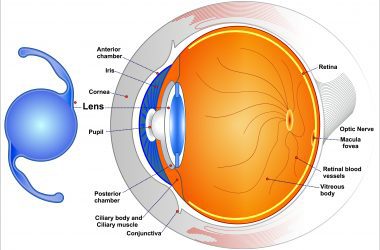Intraocular Lenses (IOLs)
-
Content written by Annie Tye, Ph.D | Reviewed by Joseph Christenbury, M.D. | Last updated 6/11/2023
- Overview
Overview
What are IOLs?
Intraocular lenses, also referred to as IOLs, are artificial lenses that can be implanted into the eye in order to correct vision problems caused by the natural lens. IOLs are often used to treat clouding of the lens caused by cataracts, though they also serve as a treatment option for a variety of other eye problems, including astigmatism and presbyopia.
Cost of IOLs
The cost for specific types of IOLs can vary. Here is the average cost for some of the most popular brands:
- Monofocal: $3,000 to $6,000 per eye. Most insurances will cover traditional monofocal lens implants.
- Multifocal: $2,000 to $4,000 per eye.
- Toric: $4,000 to $6,000 per eye.
- Accommodating: $1,500 to $3,000 per eye.
Factors affecting the cost of treatment
The cost of IOL treatments can vary depending on several factors. Here are some of the top factors:
- Ophthalmologist’s Fee: This fee can vary based on your ophthalmologist’s experience. Highly skilled surgeons may charge a premium for their expertise and services.
- Type of IOL: Multifocal and toric IOLs provide additional functionalities, and therefore tend to be more expensive than standard monofocal lenses.
- Lens Material: IOLs can be made from various materials such as acrylic, silicone, or hydrophobic. The type of material used can make a difference.
- Brand: Different companies produce IOLs, and some are considered premium brands. These higher-end options may come with an increased cost compared to standard IOLs.
- Technology: Advanced IOLs with more features, such as UV protection or blue light filtering are usually more expensive. Also, toric and multifocal IOLs that correct astigmatism or provide near and distance vision correction tend to be costlier.
- Insurance: Health insurance can greatly reduce your out-of-pocket expenses, however coverage may vary. Premium IOLs may not be fully covered. Contact your insurance company directly to find out the specifics of your coverage.
Are you a candidate?

IOLs are not typically used as a treatment for nearsightedness (myopia) or farsightedness (hyperopia) in younger individuals as there are less invasive treatments available for these common vision problems such as LASIK surgery.
Monofocal IOLs
A monofocal IOL is the most common type of intraocular lens that a surgeon places into the eye after cataract surgery. It is designed to have a single focal point, and this focal point can be customized to give the patient distance, intermediate or near vision. Typically most patients choose to have distance vision in both eyes when these lenses are implanted, and as a result the near vision is not as sharp. This can be easily treated by the patient using reading glasses.
Patients can also choose to have one eye set for distance and one for intermediate or near vision, a phenomenon called monovision. This can reduce the need for reading glasses after cataract surgery. Monovision can work well for many patients. However, some patients who choose monovision may have issues afterwards with balance and depth perception, so this should be discussed with your surgeon in the preoperative visit prior to cataract surgery. Your doctor may choose for you to do a contact lens trial of monovision prior to the surgery to see if it is acceptable.
IOL surgery with a monofocal lens is an outpatient procedure that typically takes 30 minutes or less to perform. The patient is awake during the procedure, though the eyes are anesthetized with eye drops or local anesthesia to minimize discomfort.
A small incision in the front of the eye enables the surgeon to remove the natural lens, replacing it with a multifocal lens. Once in the correct position, the incision may or may not be closed with sutures.
Some common brand names include:
- Tecnis Aspheric (Abbott Medical Optics)
- AcrySof IQ (Alcon)
- SofPort AO (Bausch + Lomb)
- Softec HD (Lenstec)
Toric IOLs
A toric IOL is a special type of monofocal IOL. In addition to correcting vision at a specified distance, it simultaneously can correct astigmatism in the cornea. It has marking points on the lens that the surgeon will use to align the toric IOL to the axis at which it will correct the maximum amount of astigmatism.
To determine which toric IOL will be used, your eye surgeon will take additional preoperative measurements (in addition to a complete eye exam) including a map of the cornea and measurement of the dimensions of your eye. These tests allow the surgeon to determine where to precisely place the lens inside your eye.
Toric IOL surgery is an outpatient procedure similar to implant a monofocal IOL and typically takes 30 minutes or less to perform. The patient is awake during the procedure, though the eyes are anesthetized with eye drops to minimize discomfort.
A small incision in the front of the eye enables the surgeon to remove the natural lens, replacing it with a multifocal lens. Once in the correct position, the incision may or may not be closed with sutures.
Some common brand names include:
- TECNIS Toric (Abbott Medical Optics)
- TRULIGN Toric (Bausch + Lomb
- AcrySof IQ Toric (Alcon)
Multifocal IOLs
Multifocal IOLs differ from traditional monofocal IOLs in that they provide vision correction across multiple distances. A standard monofocal IOL may improve distance vision while leaving near vision impaired. In fact, it is not uncommon for someone who has undergone monofocal IOL implantation to require reading glasses.
Unlike the natural lens, the artificial multifocal lens does not function by relying on the eye muscle to change the shape of the lens. Instead, it has different areas for vision at different distances similar to bifocal eyeglasses. Most multifocal IOL patients find themselves less dependent on contact lenses or glasses.
Multifocal IOL surgery is an outpatient procedure that typically takes 30 minutes or less to perform. The patient is awake during the procedure, though the eyes are anesthetized with eye drops or local anesthesia to minimize discomfort.
A small incision in the front of the eye enables the surgeon to remove the natural lens, replacing it with a multifocal lens. Once in the correct position, the incision may or may not be closed with sutures.
Some common multifocal IOL brands include
- AcrySof IQ ReSTOR
- Tecnis
Accommodating IOLs
Accommodating IOLs, are a distinct type of intraocular lens implant that also reduces the dependence on reading glasses. Like multifocal IOLs, accommodating IOLs are intended to provide sharper vision at multiple distances. Impaired accommodation is often related to the inflexibility of the aging natural lens, preventing it from sharp changes in focus. Accommodating IOLs mimic the flexibility of the eye’s natural lens by using the eye muscles to shift the position of the lens.
In general, accommodating IOL candidates are adults in good overall health with no serious eye diseases. Most patients are over 40, though some older patients may not have the eye muscle strength required to use the IOL to its fullest potential.
Generally speaking, the longer someone has used reading glasses, the weaker the muscles are likely to be. Accomodating IOLs can be used as a treatment for presbyopia, and accommodating IOLs can be implanted at the time of cataract surgery.
Unlike the bifocal-like design of multifocal IOLs, a lens that has different ‘zones’ for multiple distances, accommodating lenses have only one ‘zone,’ relying on the eye’s own focusing abilities to enable clear vision at multiple distances.
Whereas there are a number of different brands of accommodating IOLs, Bausch + Lomb’s Crystalens is one of the most frequently used FDA-approved accommodating IOLs.
Accommodating IOL implantation is an outpatient procedure that takes 30 minutes or less to perform. Anesthetic eye drops are applied before the treatment begins to help minimize patient discomfort.
The surgeon then creates a small incision in the front of the eye, through which the natural lens or cataract is removed and replaced with the accommodating IOL. Once the lens has been implanted in the eye, the incision may or may not need to be closed with sutures.
Procedure recovery time is usually one to two weeks, with most patients returning to work and resuming driving within a week.
Some common brands include
- Crystalens
- Trulign Toric
Safety information
IOL procedure are safe and effective, however, as with any surgery there are risks. Some of the potential risks and side effects include:
- Lens dislocation
- Iris capture
- Glare and halos
- Loss of contrast sensitivity
- Loss of accommodation
- Eye inflammation
Before your procedure, discuss all the potential risks and side effects with your ophthalmologist.
Recovery time
Patients are free to return home following an IOL procedure, though their vision will be blurry and they’ll need someone to drive them.
It may take the brain some time to adjust to focusing with the new IOLs. Patients typically adapt to their new vision over a period of several weeks as this adjustment occurs.
In general, patients are advised to take a week away from work and avoid anything that may irritate, strain or touch the surface of the eyes.
When will your vision improve?
On average, patients see the improvement in several hours, though most take 24-48 hours. For some patients, it can take 1-2 weeks for vision to settle while the eye adapts to the new IOL.
How long will your results last?
The results can last for a lifetime. However, if additional vision problems occur in your retina or in another part of the eye it could affect the quality of vision and additional procedures may be necessary.
EnhanceMyself.com relies on sources such as professional medical organizations, government agencies, academic institutions, and peer-reviewed scientific journals to write it’s articles. Learn more about how we ensure our content is accurate, in-depth, and unbiased by reading our editorial guidelines.
*Medical Disclaimer: This website does not provide medical advice. Read more.

